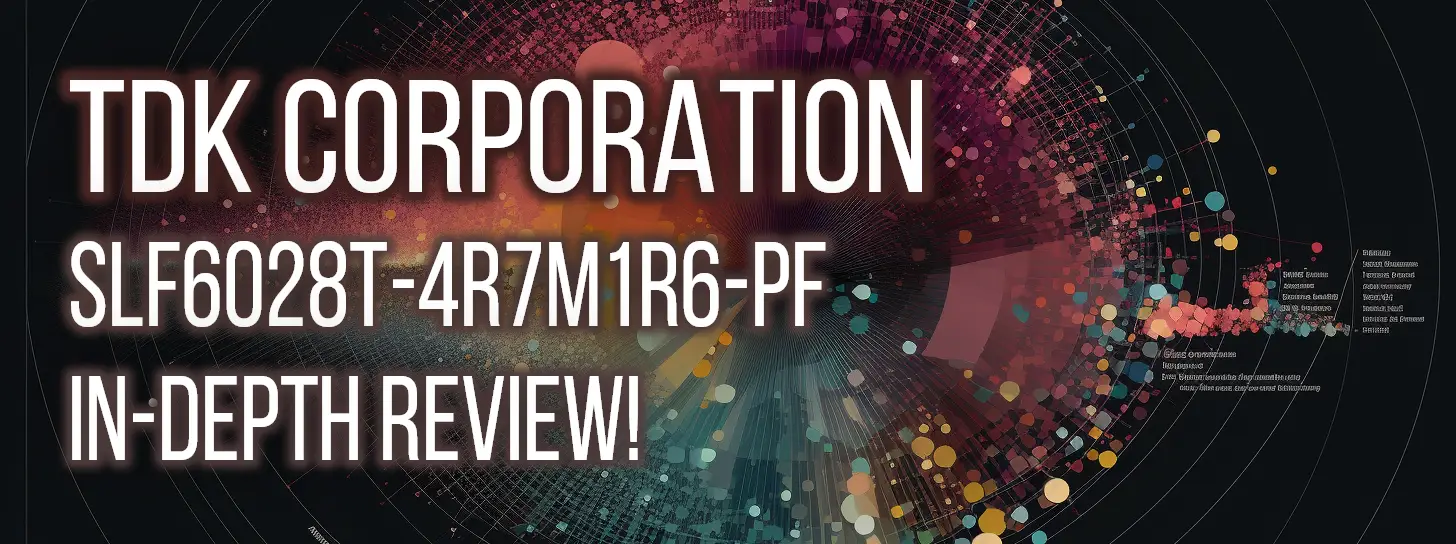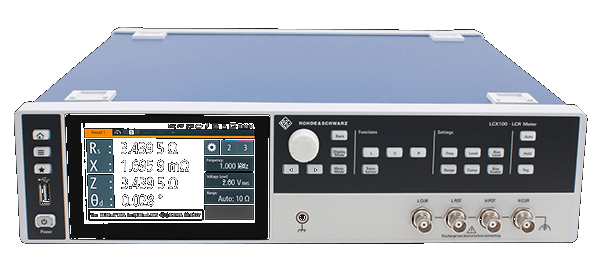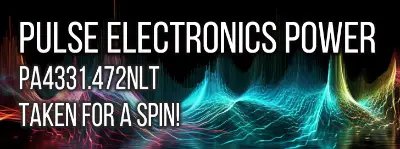TDK Corporation SLF6028T-4R7M1R6-PF: A Comprehensive Technical Review of a Competitive Drum Core Wirewound Inductor
By Mark Harris Tuesday, 30 May 2023

Introduction
In this technical review, we will be analyzing the performance of TDK Corporation's SLF6028T-4R7M1R6-PF Inductor. This Inductor is a Drum Core Wirewound type with a nominal value of 4.7μH, a 20% tolerance, a current rating of 2.5A, and a Surface Mount package. Our analysis will focus on comparing the component data against the statistical benchmark data obtained from other components with similar values. The target audience for this review are electronics engineers evaluating whether they should use this Inductor.
First, let's go through the pros and cons of this component based on the results of LCR (Inductance, Capacitance, and Resistance) measurements at multiple test frequencies and two voltage levels, 1V and 10V:
Impedance
In this section, we concentrate on the impedance performance of the SLF6028T-4R7M1R6-PF Inductor. To provide an accurate comparison, we will analyze the inductor's impedance data at two voltage levels (1 Volt and 10 Volts) and contrast it against the statistical benchmark data of similar components.
Beginning with the 1 Volt test frequency data, the SLF6028T-4R7M1R6-PF demonstrates higher impedance values than the statistical benchmark across the entire frequency range. This indicates that the inductor may exhibit slightly higher power losses during its operation when compared to the average industry benchmarks. For instance, at 10 kHz, the impedance value is 319.2m Ohms, compared to the benchmark's average of 256.3m Ohms. Similarly, at 500 kHz, the component presents an impedance of 15.04 Ohms, which surpasses the benchmark's statistical average of 14.29 Ohms. These disparities between the SLF6028T-4R7M1R6-PF and the benchmark data continue throughout the tested frequency range, suggesting that the inductor has a distinctive performance curve.
Comparing the SLF6028T-4R7M1R6-PF inductor's 10 Volt LCR measurements to the benchmark data reveals consistency in the behavior observed at 1 Volt. The inductor demonstrates significant deviations in impedance values from the statistical benchmark across the entire frequency range, reinforcing the unique performance characteristics of this component. For example, at 50 kHz, the SLF6028T-4R7M1R6-PF component exhibits an impedance of 1.653 Ohms, compared to the benchmark's average of 1.562 Ohms. Likewise, at 1 MHz, the inductor's impedance stands at 30.78 Ohms, surpassing the benchmark's average of 28.31 Ohms.
It is essential for designers to consider these impedance deviations while selecting an inductor for specific applications. Designers must also be aware of the potential implications of these variations in impedance values on the overall system performance and efficiency, particularly in filtering and energy storage applications, where impedance plays a crucial role.
Inductance
The TDK Corporation's SLF6028T-4R7M1R6-PF inductor offers a nominal inductance of 4.7μH with a ±20% tolerance. Analyzing its inductance performance against the statistical benchmark data for other components of the same value at 1 Volt test condition yielded significant observations.
At test frequency values ranging from 5kHz to 1MHz, the SLF6028T-4R7M1R6-PF demonstrated relatively higher inductance values than the statistical benchmark for lower frequencies, especially at 5kHz and 10kHz. At 5kHz, the measured inductance value was 17.26μH as opposed to the benchmark's average of 15.29μH. Similarly, at 10kHz, the component exhibited an inductance value of 17.84μH compared to the benchmark's average of 11.59μH. These results indicate superior performance of the SLF6028T-4R7M1R6-PF inductor in lower-frequency applications.
Nonetheless, as the test frequency increased, this inductor's performance began to converge with the benchmark's average. For instance, at 100kHz, the inductor exhibited a 4.944μH-series inductance, only marginally higher than the benchmark average of 4.593μH. The inductor's performance also became quite consistent with the benchmark data, closely following the peak values at higher frequency ranges from 450kHz to 1MHz.
When comparing the two sets of LCR measurements, the SLF6028T-4R7M1R6-PF displayed a decline in series inductance values at higher voltage (10 Volts) across the frequency range. It is crucial to understand that the inductance of a component may vary with the applied voltage. However, for most real-world applications, the 1 Volt test condition offers a suitable and accurate comparison to the statistical benchmark, as it represents the most common operating voltage for various electronic devices, complying with the component's specifications.
Series Resistance
Dissipation Factor and Quality Factor
When analyzing the TDK SLF6028T-4R7M1R6-PF Inductor's LCR measurements at 1 volt, a noticeable trend becomes evident in the Quality Factor (Q) and frequency relationship. The Q Factor increases with the rise in frequency, ranging from a low value of 0.02 at 5 Hz up to an impressive 27.05 at 1 MHz. The peak Q factor of 26.73 is achieved at a frequency of 100 kHz, and it maintains a consistent value throughout the entire range up to 1 MHz, indicating high-quality energy storage capabilities in this frequency band.
However, when comparing the same SLF6028T-4R7M1R6-PF Inductor's LCR measurements at a higher voltage of 10 volts, an interesting observation is made that the Q Factor significantly reduces compared to the measurements obtained at 1 volt. Under this higher voltage evaluation, a peak Q factor of 21.13 is reached at a frequency of 75 kHz. Additionally, a gradual decrease in the Quality Factor is identified as the frequency rises from 75 kHz towards 1 MHz, with the value dropping to 17.17 at the top end of the range. This highlights the dependency of the Q factor on both frequency and input voltage.
Bearing in mind that the observed Q Factor values are dependent on specific testing conditions, the TDK SLF6028T-4R7M1R6-PF Inductor exhibits satisfactory performance overall. Nevertheless, it is essential for engineering professionals to assess this component in the context of its intended application and the desired performance requirements. A clear understanding of the Quality Factor and its dependency on factors such as frequency and input voltage will aid engineers in determining whether this inductor is the optimal choice for their specialized needs and performance benchmarks.
Comparative Analysis
In this comparative analysis, we will examine the performance of the TDK Corporation SLF6028T-4R7M1R6-PF Inductor, a Drum Core, Wirewound surface mount inductor with a nominal value of 4.7μ, a tolerance of ±20%, and a current rating of 2.5A. We will compare its performance against the average performance of Inductors with the same value, focusing on Impedance, Quality Factor, Series Resistance, and Series Inductance, in relation to the statistical benchmark data provided.
Upon examining the LCR measurements at 1 Volt, we can observe that, in most cases, the SLF6028T-4R7M1R6-PF Inductor exhibits better-than-average performance compared to the benchmark. For instance, in the frequency range of 5k-100k, the Inductor consistently shows higher Quality Factors than the average, reaching up to a maximum of 27.46 at 150k, compared to the benchmark's average maximum of 26.73 at the same frequency. In addition, the Inductor has a lower Series Resistance across most of the frequency range of 5-1M, showcasing better energy efficiency when conducting current.
However, the inductor does show some shortcomings in comparison with the statistical data. Specifically, the Series Inductance of the SLF6028T-4R7M1R6-PF Inductor is generally marginally lower than the benchmark average between the range of 5k-1M. This may result in lower inductive reactance in some circuits where a higher inductive reactance is desired.
When evaluating the LCR measurements at 10 Volts, the SLF6028T-4R7M1R6-PF Inductor presents a somewhat similar story, with strong performance regarding Quality Factor and Series Resistance, predominantly in the frequency range of 50k-1M. Overall, the Inductor maintains its competitive advantage against the statistical benchmark data in these areas.
In conclusion, the TDK Corporation SLF6028T-4R7M1R6-PF Inductor demonstrates superior performance in terms of Quality Factor and Series Resistance, making it a reliable and energy-efficient choice for use in circuits, especially at higher frequencies. Nonetheless, it exhibits a marginally lower Series Inductance in comparison to the benchmark average, which engineers should be mindful of when seeking optimum inductive reactance in their circuits.
Conclusion
In this technical review, we analyzed the performance of TDK Corporation's SLF6028T-4R7M1R6-PF inductor, a drum-core, wire-wound component with a nominal value of 4.7 μH, ±20% tolerance, and a current rating of 2.5 A. The evaluation targeted electronics engineers who might be considering implementing this inductor and gauging its performance in comparison to the statistical benchmark data.
When observing the LCR measurements for the SLF6028T-4R7M1R6-PF inductor at 1 volt, it is apparent that the inductor has higher impedance, series resistance, and series inductance compared to the average values of the statistical benchmark data across various test frequencies. However, the quality factor of the SLF6028T-4R7M1R6-PF inductor is significantly lower than the average quality factor of the statistical benchmark data samples. This indicates that the SLF6028T-4R7M1R6-PF inductor may have higher energy loss and lower resonance compared to other inductors within the same value range.
When the inductor is tested at 10 volts, the results show a similar trend. The SLF6028T-4R7M1R6-PF inductor has higher impedance and series inductance while the quality factor remains far below the benchmark's average values. The results suggest that the SLF6028T-4R7M1R6-PF inductor might not be an optimal choice for applications that require high quality factor and minimal energy loss.
In conclusion, TDK Corporation's SLF6028T-4R7M1R6-PF inductor offers higher impedance, series resistance, and series inductance performance when compared to the statistical benchmark data. However, its low quality factor may pose limitations to its suitability in applications requiring minimal energy loss and high resonance. Engineers should carefully assess the specific requirements of their application before selecting the SLF6028T-4R7M1R6-PF inductor in their design.
Instruments Used
Rohde & Schwarz LCX200



